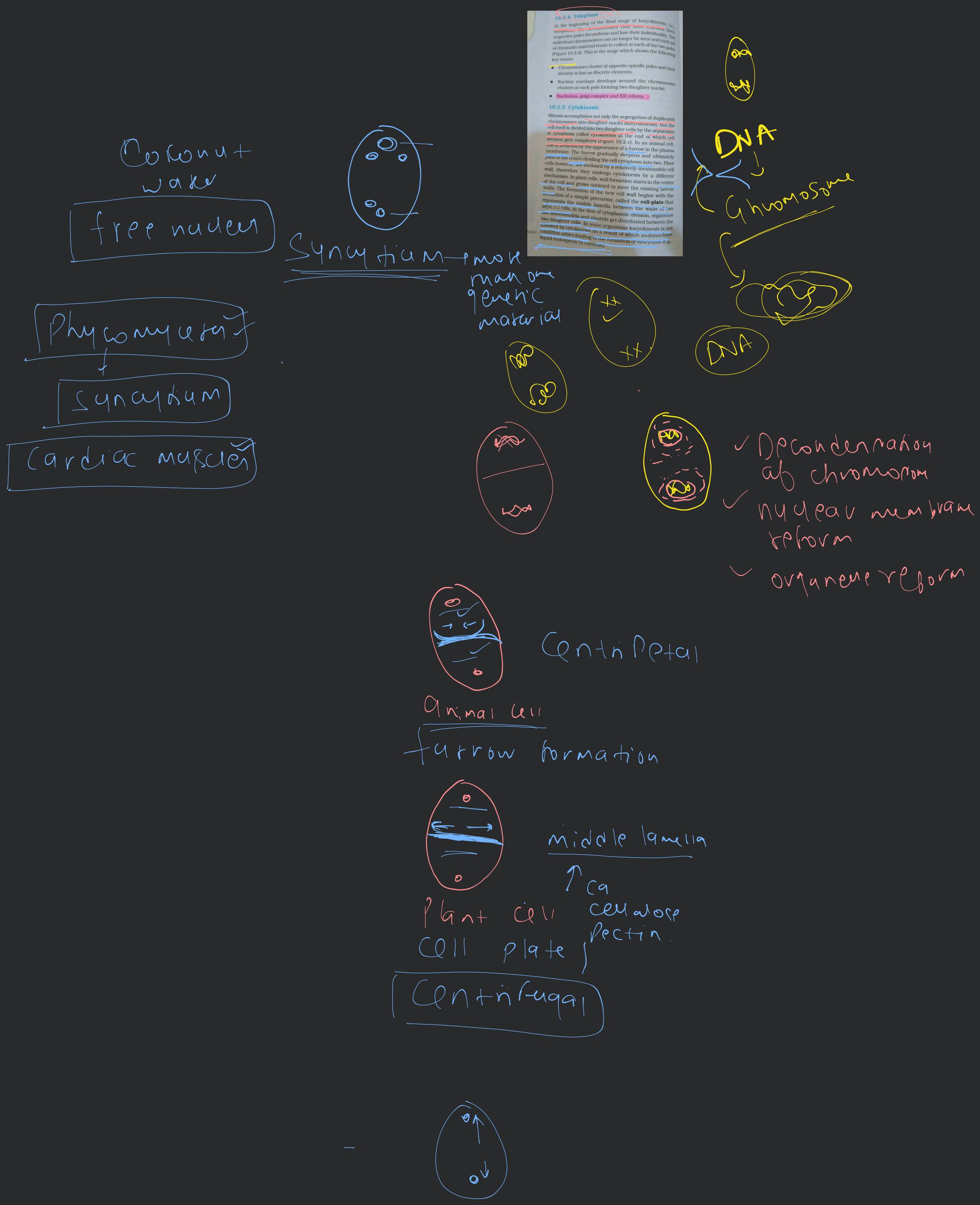Question
Question asked by Filo student

10.2.5 Cytokinesis Mitosis accomplishes not only the segregation of duplicated chromosomes into daughter nuclei (karyokinesis), but the cell itself is divided into two daughter cells by the separation of cytoplasm called cytokinesis at the end of which cell division gets completed (Figure e). In an animal cell, this is achieved by the appearance of a furrow in the plasma membrane. The furrow gradually deepens and ultimately joins in the centre dividing the cell cytoplasm into two. Plant cells however, are enclosed by a relatively inextensible cell wall, thererfore they undergo cytokinesis by a different mechanism. In plant cells, wall formation starts in the centre of the cell and grows outward to meet the existing lateral walls. The formation of the new cell wall begins with the formation of a simple precursor, called the cell-plate tnat represents the middle lamella between the walls of two adjacent cells. At the time of cytoplasmic division, organelles like mitochondria and plastids get distributed between the two daughter cells. In some organisms karyokinesis is not followed by cytokinesis as a result of which multinucleate condition arises leading to the formation of syncytium (e.g." liquid endosperm in coconut).
Found 8 tutors discussing this question
Discuss this question LIVE
10 mins ago
Filo tutor solutions (3)
Learn from their 1-to-1 discussion with Filo tutors.
8 mins
Uploaded on: 12/12/2022
Was this solution helpful?
120
Share
Report
18 mins
Uploaded on: 4/20/2023
Was this solution helpful?
78
Share
Report

One destination to cover all your homework and assignment needs
Learn Practice Revision Succeed

Instant 1:1 help, 24x7
60, 000+ Expert tutors

Textbook solutions
Big idea maths, McGraw-Hill Education etc

Essay review
Get expert feedback on your essay

Schedule classes
High dosage tutoring from Dedicated 3 experts
Practice more questions on Cell: Structure and Functions
Question 1
Hard
Views: 5,855
Question 2
Easy
Views: 5,407
Students who ask this question also asked
Question 1
Views: 5,891


Stuck on the question or explanation?
Connect with our Biology tutors online and get step by step solution of this question.
231 students are taking LIVE classes
| Question Text | 10.2.5 Cytokinesis
Mitosis accomplishes not only the segregation of duplicated chromosomes into daughter nuclei (karyokinesis), but the cell itself is divided into two daughter cells by the separation of cytoplasm called cytokinesis at the end of which cell division gets completed (Figure e). In an animal cell, this is achieved by the appearance of a furrow in the plasma membrane. The furrow gradually deepens and ultimately joins in the centre dividing the cell cytoplasm into two. Plant cells however, are enclosed by a relatively inextensible cell wall, thererfore they undergo cytokinesis by a different mechanism. In plant cells, wall formation starts in the centre of the cell and grows outward to meet the existing lateral walls. The formation of the new cell wall begins with the formation of a simple precursor, called the cell-plate tnat represents the middle lamella between the walls of two adjacent cells. At the time of cytoplasmic division, organelles like mitochondria and plastids get distributed between the two daughter cells. In some organisms karyokinesis is not followed by cytokinesis as a result of which multinucleate condition arises leading to the formation of syncytium (e.g." liquid endosperm in coconut).
|
| Updated On | Apr 20, 2023 |
| Topic | Cell: Structure and Functions |
| Subject | Biology |
| Class | Class 12 |
| Answer Type | Video solution: 3 |
| Upvotes | 297 |
| Avg. Video Duration | 12 min |




